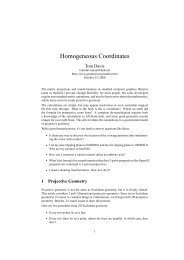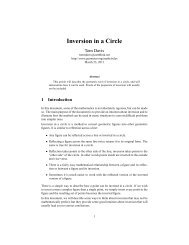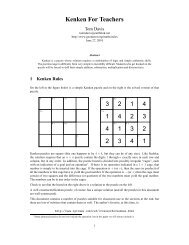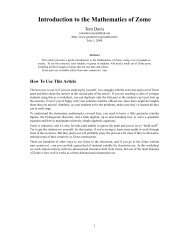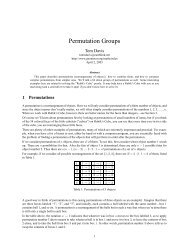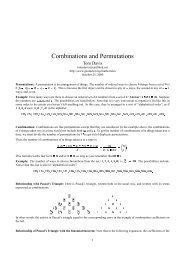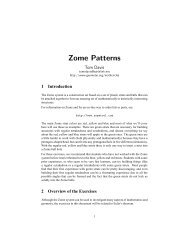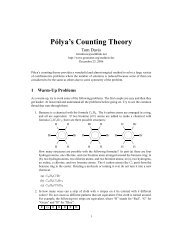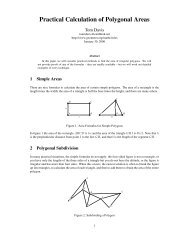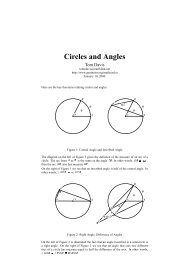Pick's Theorem - Home Page -- Tom Davis
Pick's Theorem - Home Page -- Tom Davis
Pick's Theorem - Home Page -- Tom Davis
Create successful ePaper yourself
Turn your PDF publications into a flip-book with our unique Google optimized e-Paper software.
Part I<br />
Examples<br />
Pick’s <strong>Theorem</strong><br />
<strong>Tom</strong> <strong>Davis</strong><br />
tomrdavis@earthlink.net<br />
Oct 27, 2003<br />
Pick’s <strong>Theorem</strong> provides a method to calculate the area of simple polygons whose<br />
vertices lie on lattice points—points with integer coordinates in the x-y plane. The<br />
word “simple” in “simple polygon” only means that the polygon has no holes, and that<br />
its edges do not intersect. The polygons in Figure 1 are all simple, but keep in mind<br />
that the word “simple” may apply only in a technical sense—a simple polygon could<br />
have a million edges!<br />
A<br />
B<br />
D<br />
F<br />
C<br />
E<br />
Figure 1: Pick’s <strong>Theorem</strong> Examples<br />
Obviously for polygons with a large interior, the area is going to be roughly approximated<br />
by the number of lattice points in the interior. You might guess that a slightly<br />
better approximation can be gotten by adding about half the lattice points on the boundary<br />
since they are sort of half inside and half outside the polygon. But let’s look at a<br />
few examples in Figure 1.<br />
For all the examples below, we’ll letI be the number of interior vertices, andB be the<br />
number of boundary vertices. We will use the notation A(P) to indicate the area of<br />
polygon P .<br />
A: I = 0, B = 4, A(A) = 1, I +B/2 = 2.<br />
B: I = 0, B = 3, A(B) = 1/2, I +B/2 = 3/2.<br />
1
C: I = 28, B = 26, A(C) = 40, I +B/2 = 41.<br />
D: I = 7, B = 12. A(D) = 12, I +B/2 = 13.<br />
E: It is a bit trickier to calculate the areas of polygons E and F . E can be broken<br />
into a6×3 rectangle and two identical triangles with base 3 and height 5, so we<br />
get I = 22, B = 24 A(E) = 33, I +B/2 = 34.<br />
F: It is even uglier to calculate the area for this one, but after some addition and<br />
subtraction of areas, we find that: I = 9, B = 26, A(F) = 21, I +B/2 = 22.<br />
What is amazing is that if you look at all six examples above, the estimate I + B/2<br />
is always off by exactly one. It appears that for any lattice polygon P , the following<br />
formula holds exactly:<br />
A(P) = I p +B p /2−1,<br />
whereI p is the number of lattice points completely interior toP andB p is the number<br />
of lattice points on the boundary of P .<br />
This is called Pick’s <strong>Theorem</strong>.<br />
Try a few more examples before continuing.<br />
Part II<br />
Pick’s <strong>Theorem</strong> for Rectangles<br />
Rather than try to do a general proof at the beginning, let’s see if we can show that<br />
Pick’s <strong>Theorem</strong> is true for some simpler cases. The easiest one to look at is latticealigned<br />
rectangles.<br />
m<br />
n<br />
Figure 2: Pick’s <strong>Theorem</strong> for Rectangles<br />
The particular rectangle in Figure 2 is 14 × 11 (m = 14 and n = 11), so it has area<br />
14 · 11 = 154. And it’s easy to count the interior and boundary points—there are<br />
2
13 × 10 = 130 interior points, and there are 50 boundary points. I + B/2 − 1 =<br />
130+50/2−1 = 154, so for this particular rectangle, Pick’s <strong>Theorem</strong> holds.<br />
But what about an arbitrary m × n rectangle? The area is clearly mn, and it’s easy<br />
to convince yourself (by drawing a few examples, if necessary), that the number of<br />
interior points is given by I = (m−1)(n−1). You can also see that B = 2m+2n<br />
(why?), so for an m×n rectangle:<br />
I +B/2−1 = (m−1)(n−1)+2(m+n)/2−1<br />
= (mn−m−n+1)+(m+n)−1<br />
= mn,<br />
which is exactly what we wanted to show.<br />
Part III<br />
Lattice-Aligned Right Triangles<br />
Just slightly harder is to show that the formula holds for right triangles where the legs<br />
of the triangle lie along lattice lines. The easiest way to show this is to think of such a<br />
triangle as half of one of the rectangles in the previous part where a diagonal is added.<br />
Some examples appear in Figure 3.<br />
Figure 3: Pick’s <strong>Theorem</strong> for Right Triangles<br />
We will look at such a triangle T with legs of length m and n. The area is clearly<br />
mn/2, but how many interior and boundary points are there? As you can see from<br />
Figure 3, it is easy to count the boundary vertices along the legs, but sometimes the<br />
diagonal hits lots of lattice points, sometimes none, and sometimes it hits just a few of<br />
them.<br />
But it turns out that it doesn’t matter. For an arbitrary right triangle with legs of lengths<br />
m andnand areamn/2, suppose there arek points on the diagonal, not counting those<br />
3
on the ends (the triangle vertices). The number of boundary points is m+n+1+k<br />
(why?).<br />
The number of interior points is also easy to calculate. Before you added the diagonal<br />
to the rectangle, there were (m − 1)(n − 1) interior points. If you subtract from this<br />
the k points on the boundary, the remainder are split into two halves by the diagonal,<br />
so in total the triangle has ((m−1)(n−1)−k)/2 interior points.<br />
Checking Pick’s <strong>Theorem</strong> for a right triangle with lattice-aligned legs, we get:<br />
I +B/2−1 = (m−1)(n−1)−k<br />
2<br />
+ m+n+1+k<br />
2<br />
−1<br />
= mn<br />
2 − m 2 − n 2 + 1 2 − k 2 + m 2 + n 2 + 1 2 + k 2 −1<br />
= mn<br />
2 = A(T).<br />
Part IV<br />
Pick’s <strong>Theorem</strong> for General Triangles<br />
A<br />
T<br />
B<br />
C<br />
Figure 4: Pick’s <strong>Theorem</strong> for Triangles<br />
Assuming that we know that Pick’s <strong>Theorem</strong> works for right triangles and for rectangles,<br />
we can show that it works for arbitrary triangles. In reality there are a bunch of<br />
cases to consider, but they all look more or less like variations of Figure 4, where there<br />
is an arbitrary triangle T that can be extended to a rectangle with the addition of a few<br />
right triangles. In the case of this figure, three additional right triangles are required:<br />
A, B, and C.<br />
Suppose that triangle A has I a interior points and B a boundary points, that triangle B<br />
has I b interior points and B b boundary points, et cetera. Call the rectangle R, and let<br />
R haveI r interior andB r boundary points. Since we know that Pick’s <strong>Theorem</strong> works<br />
4
for right triangles and rectangles we have:<br />
A(A) = I a +B a /2−1<br />
A(B) = I b +B b /2−1<br />
A(C) = I c +B c /2−1<br />
A(R) = I r +B r /2−1.<br />
We want to show that<br />
A(T) = I t +B t /2−1.<br />
We know that<br />
A(T) = A(R)−A(A)−A(B)−A(C) (1)<br />
= I r −I a −I b −I c +(B r −B a −B b −B c )/2+2. (2)<br />
Suppose that the rectangleRism×n (so it has areaA(R) = mn, hasB r = 2m+2n,<br />
and has I r = (m−1)(n−1)). If we count the boundary points carefully, we have:<br />
B a +B b +B c = B r +B t ,<br />
or<br />
B r = B a +B b +B c −B t , (3)<br />
since the acute-angled vertices of the surrounding triangles are double-counted on both<br />
sides of the equation.<br />
Counting (again carefully) the interior points of the rectangle, we get:<br />
I r = I a +I b +I c +I t +(B a +B b +B c −B r )−3. (4)<br />
We need the final −3 in the equation above because now the corners of the triangles<br />
really are double-counted.<br />
Substitute the value of B r in Equation 3 into Equation 4:<br />
I r = I a +I b +I c +I t +B t −3. (5)<br />
Now we just substitute the values forB r andI r from Equations 3 and 5 into Equation 2<br />
to obtain (after a bit of algebra):<br />
A(T) = I r −I a −I b −I c +(B r −B a −B b −B c )/2+2<br />
= (I a +I b +I c +I t +B t −3)−I a −I b −I c<br />
+((B a +B b +B c −B t )−B a −B b −B c )/2+2<br />
= I t +B t −3−B t /2+2<br />
= I t +B t /2−1,<br />
which is exactly what we wanted to show.<br />
If you would like to check the equations above with the example in Figure 4, here are<br />
the values for all four triangles and the rectangle:<br />
5
I B A = I +B/2−1<br />
A 10 18 18 = 10+18/2−1<br />
B 16 20 25 = 16+20/2−1<br />
C 15 16 22 = 15+16/2−1<br />
T 40 12 45 = 40+12/2−1<br />
R 90 42 110 = 90+42/2−1<br />
Part V<br />
Pick’s <strong>Theorem</strong>: General Case<br />
We now know that Pick’s <strong>Theorem</strong> is true for arbitrary triangles with their vertices on<br />
lattice points. (Well, we do if we have checked a few additional cases that are similar<br />
to the one that appears in the previous section.) How do we show that it is true for an<br />
arbitrary simple polygon P with vertices that are lattice points?<br />
1 Overview of the Proof<br />
Intuitively, what we will do is show that any such polygon can be constructed by putting<br />
together smaller polygons where we know that Pick’s theorem is true. Roughly, we<br />
will go about it as follows. We have already shown that every 3-sided lattice polygon<br />
satisfies Pick’s <strong>Theorem</strong>. Next, we show that if it’s true for all 3-sided polygons, it is<br />
also true for all 4-sided polygons. Then we show that if it’s true for all 3- and 4-sided<br />
polygons, it is true for all 5-sided polygons. Then we show that if it’s true for all 3-, 4-,<br />
and 5-sided polygons, it is true for all 6-sided polygons, et cetera.<br />
This technique is officially known as generalized mathematical induction, and we will<br />
not, in practice, do all of the infinite number of steps that we began to describe in the<br />
previous paragraph. We will do the proof in two steps, the first of which has already<br />
been completed:<br />
1. Show that the theorem is true for every lattice polygon having 3 sides.<br />
2. Show that if the theorem is true for every lattice polygon having 3 or 4 or 5 or<br />
. . . ork−1 sides, then it is true for every lattice polygon having k sides.<br />
Since the second part of the proof works for any k, it effectively amounts to doing all<br />
of the infinite number of steps listed a couple of paragraphs previously.<br />
A particular example of the general idea is illustrated in Figure 5. We have a 23-sided<br />
polygon: ABC···W . We will show that every such polygon with more than three<br />
sides has an interior diagonal (there are lots of examples in this figure, but we have<br />
chosen diagonal OW as an example), and such a diagonal will split the polygon into<br />
a pair of smaller polygons. In this case, into the 16-sided polygon ABC···MNOW<br />
and the 9-sided polygon OPQ···W . Since we are this stage in the proof, we know<br />
Pick’s <strong>Theorem</strong> is true for all polygons having between 3 and 22 edges, then in particular<br />
it will be true for the 16- and 9-sided polygons above. We then show that if two<br />
6
A<br />
B<br />
L<br />
D<br />
C<br />
M<br />
H<br />
I<br />
O<br />
N<br />
P<br />
V<br />
W<br />
Q<br />
J<br />
K<br />
U<br />
T<br />
G<br />
E<br />
S<br />
R<br />
F<br />
Figure 5: Pick’s <strong>Theorem</strong>: General Case<br />
such polygons that satisfy Pick’s <strong>Theorem</strong> are attached together, the resulting polygon<br />
will also satisfy Pick’s <strong>Theorem</strong>.<br />
We will show the second part first—that if two polygons satisfy the theorem, then the<br />
joined version will also satisfy the theorem.<br />
2 Joining Two Lattice Polygons<br />
Suppose the two sub-polygons of the original polygon P are P 1 and P 2 , where P 1 has<br />
I 1 interior points and B 1 boundary points. P 2 has I 2 interior and B 2 boundary points.<br />
Let’s also assume that the common diagonal of the original polygon between P 1 and<br />
P 2 contains m points. Let P have I interior and B boundary points.<br />
A(P) = A(P 1 )+A(P 2 ) = (I 1 +B 1 /2−1)+(I 2 +B 2 /2−1).<br />
Since any point interior to P 1 or P 2 is interior to P , and since m − 2 of the common<br />
boundary points of P 1 and P 2 are also interior to P , I = I 1 + I 2 + m − 2. Similar<br />
reasoning gives B = B 1 +B 2 −2(m−2)−2.<br />
Therefore:<br />
I +B/2−1 = (I 1 +I 2 +m−2)+(B 1 +B 2 −2(m−2)−2)/2−1<br />
7
= (I 1 +B 1 /2−1)+(I 2 +B 2 /2−1)<br />
= A(P).<br />
3 The Interior Diagonal<br />
To complete the proof of Pick’s <strong>Theorem</strong>, we must show that any simple polygon has<br />
an interior diagonal—a diagonal completely within the polygon that connects two of<br />
its vertices.<br />
A<br />
K<br />
G<br />
B<br />
J<br />
I<br />
L<br />
C<br />
Figure 6: Existence of an Interior Diagonal<br />
The proof goes as follows. Find an angle ̸ ABC such that the interior of the polygon<br />
is on the side of the angle less than 180 ◦ . Then there are two cases. Either the line<br />
segment AC lies completely within the polyon in which case we are done, and AC is<br />
the required diagonal, or some part of the polygon (shown asGJKL in Figure 6) goes<br />
inside△ABC.<br />
There are only a finite number of vertices of the polygon interior to△ABC; for each of<br />
those, construct a line perpendicular to the angle bisector of ̸ ABC. Clearly, the line<br />
connecting B to the vertex with perpendicular closest to point B will lie completely<br />
within the polygon. If not, it had to cross another edge of the polygon, and one end of<br />
that edge would have a perpendicular to the angle bisector closer toB.<br />
Note that we cannot use the vertex closest to B. In Figure 6, J is the point nearest B,<br />
but clearly segment JB crosses segment KL.<br />
Part VI<br />
Polygons with Holes<br />
So far, all of the polygons we have considered are simple—they have no holes. In<br />
figure 7 are five examples of polygons with holes. Polygons A, B and C have a single<br />
8
A<br />
B<br />
C<br />
D<br />
E<br />
Figure 7: Polygons with holes<br />
hole, while polygonsD andE each have two holes. These examples are simple enough<br />
that it is not difficult to calculate the areas enclosed inside the outer polygon and outside<br />
the hole or holes.<br />
I B A I +B/2−1<br />
A 0 16 8 7<br />
B 8 30 23 22<br />
C 6 19 15.5 14.5<br />
D 8 40 29 27<br />
E 3 52 30 28<br />
The table above shows the counts, including the actual area and the area predicted by<br />
the formula that works for polygons without holes. In the cases where there is one hole,<br />
there is an error of 1; in the cases where there are two holes, the error is 2. In fact, if<br />
you try a few more examples with one, two or more holes and add additional entries to<br />
the table above, you will find that the area seems to be given by the following formula,<br />
where n is the number of holes:<br />
A = I +B/2−1+n.<br />
Since we already know the formula for the areas of polygons without holes, we can use<br />
that information to work out the area of a polygon with holes. We will first work out<br />
the formula for the area of a polygon with a single hole and then we will extend that<br />
calculation to the general case of n holes.<br />
For the single hole case, we need to show that the area of the polygon is given by the<br />
formulaI +B/2−1+1 = I +B/2.<br />
Suppose the outer polygon has areaA o , hasI o interior points andB o boundary points.<br />
The polygon that makes up the hole has area A h and has I h interior points and B h<br />
boundary points.<br />
9
From our previous work, we know thatA o = I o +B o /2−1 andA h = I h +B h /2−1.<br />
Since A = A o −A h , we have<br />
A = I o −I h +(B o −B h )/2.<br />
If I and B are the number of interior and boundary points of the entire polygon that<br />
includes the hole, we haveI = I o −I h −B h andB = B o +B h . Using these formulas<br />
and a little algebra, we obtain:<br />
I +B/2 = I −I h +(B o −B h )/2 = A,<br />
which is exactly what we were trying to prove.<br />
4 The General Case with n Holes<br />
A similar calculation can be made for polygons with any number of holes. As before,<br />
let A o be the area of the outer polygon (with I o and B o interior and boundary points)<br />
have n holes with areas A 〉 , 1 ≤ i ≤ n and having I i and B i interior and boundary<br />
points.<br />
The area A of the “holey” polygon (having I and B interior and boundary points) is<br />
given by:<br />
n∑<br />
A = A o − A i .<br />
i=1<br />
Since A o = I o +B o /2−1 and A i = I i +B i /2−1 we have:<br />
A = I o +B o /2−1−<br />
n∑<br />
(I i +B i /2−1)<br />
i=1<br />
= I o +B o /2−1+n−<br />
n∑<br />
(I i +B i /2).<br />
It is easy to see that I = I o − ∑ n<br />
i=i (I i +B i ) and that B = B o + ∑ n<br />
i=i B i. Thus:<br />
I +B/2−1+n = I o +B o /2−<br />
which is exactly what we were trying to prove.<br />
i=1<br />
n∑<br />
(I i +B i /2)−1+n = A,<br />
i=1<br />
10





